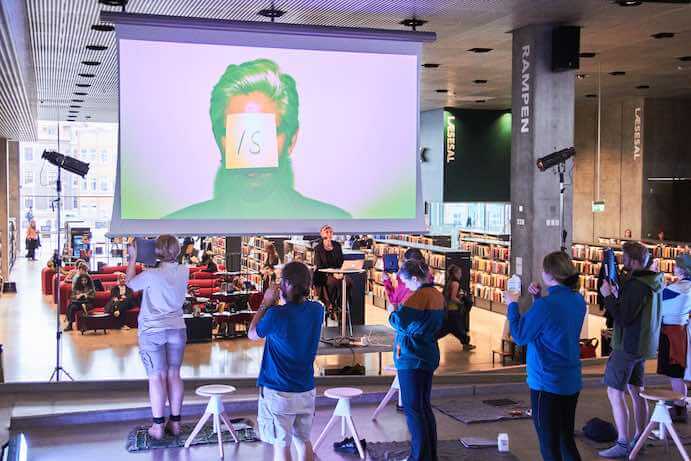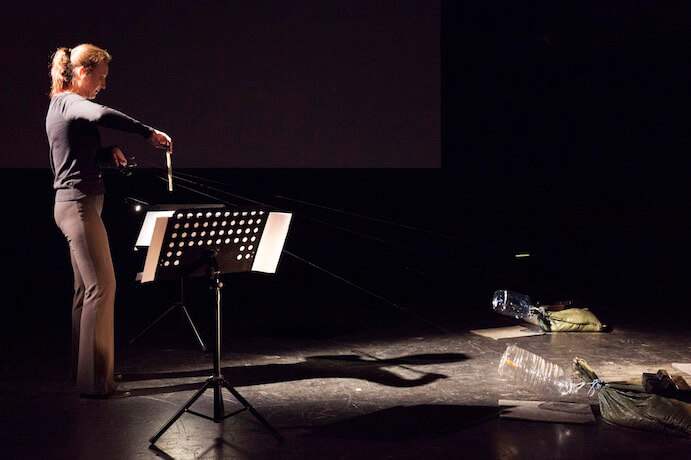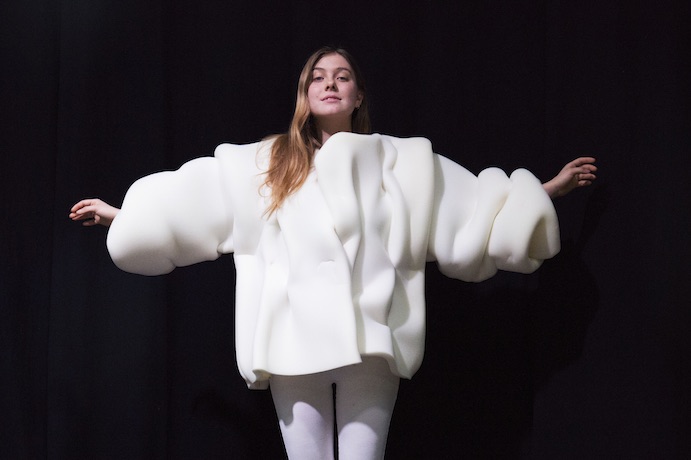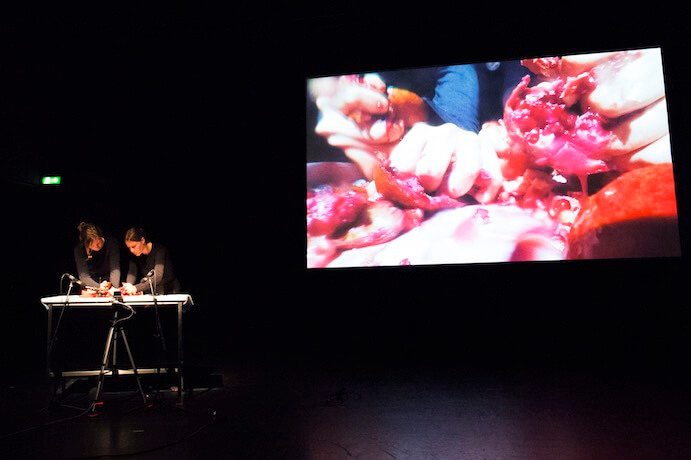One of the many goals of Denmark’s annual SPOR festival is to feature contemporary art that is sound-oriented rather than solely focusing on composed music. At this year’s festival, multimedia installations throughout the city and new works selected from SPOR’s Call for Proposals embodied this idea of contemporary music as sound art. These works included the Scandinavian premiere of Manos Tsangaris’ site-specific theatrical work Living Spaces (2016-17), a product pitch for Nico Sauer’s The AcouSuit, and world premiere performances of Alexander Khubeev’s The Hum and Caroline Louise Miller’s Vivarium.
Manos Tsangaris’ Living Spaces was one of many installations staged in public places throughout the city and spanning multiple days of the festival. Living Spaces consists of four live music installations, and was performed by SCENATET in various stations throughout the DOKK1 Library. The most visible installation, WAIT! for 20 choral singers, was staged in the main hall at the base of the large central stairway. The choir completed a series of tasks called out by conductor Vivianne Sydnes, which included conducted songs, improvisatory group singing, twirling handheld objects, synchronized body movements, and lying on the floor to rest. As both SPOR attendees and unsuspecting library patrons filtered through this resonant, open space, the looped actions of the choir became an extension of everyday reality and permeated the public space.

Manos Tsangaris’ Living Spaces–Photo by Frederikke Hoeijmans
The new works selected from SPOR’s 2017 Call for Proposals were presented on May 13th in the Teater Katapult at Godsbanen. While the original program for the evening included four selected works, visa issues prevented the Boston-based, Turkish born composer/performer Murat Çolak from premiering his work Kanal for synthesizer with effect pedals, bass shakers, and surface transducers—which was sorely missed. Instead, the extremely short evening presented two world premieres and one new product pitch.
First on the program was Russian composer Alexander Khubeev’s The Hum, which explores the human connection to mysterious low frequency droning sounds heard around the globe. As the audience entered the theater, performer Yulia Migunova stood with one hand entwined in a bundle of steel strings, each of which were stretched across the stage in various directions and attached to water jugs acting as resonators. Throughout the performance, Migunova controlled the tension and position of the strings while she bowed and plucked, producing a range of ominous scraping, clattering, clanging sounds. Bow hairs began to disintegrate as bow pressure increased, and an eerie creaking produced by sliding the bow lengthwise across the strings concluded the performance. While the diversity of timbres produced by this specially constructed instrument was intriguing, the 15-minute performance seemed too long for the range of techniques displayed. Additionally, Migunova’s decision to throw sheets of score on the ground in lieu of finding another method of page turning audibly disrupted the unique sound world of the performance.

Yulia Migunova performs Alexander Khubeev’s The Hum–Photo by Emilie Kiilerich
Next, German artist Nico Sauer took the stage with model Lovisa Björna clad in The AcouSuit: a foam cloud reminiscent of the Michelin Man. Capable of diffracting and absorbing different sound waves, The AcouSuit is a unique, wearable garment that serves as a representation of the wearer’s individuality of perception. In his product pitch, Sauer explained that while composers can create and determine sound events, the uncontrollable filter of audience perception ultimately controls the music. It is still a bit unclear as to how the garment affects the listener experience, but the size and shape of The AcouSuit are determined by a test that generates a psycho-sonographic map of the listener’s sonic perception. Starting at €299, seemingly cumbersome to wear, and larger than your average concert hall seat, it remains to be seen if The AcouSuit is truly the way of the concert-going future.

Nico Sauer’s The Acousuit–Photo by Emilie Kiilerich
United States composer Caroline Louise Miller’s Vivarium (pictured in feature image) concluded the evening and forced the concept of music as sound art to the forefront. The work explores fetishism and relationships between organic entities through a visually and sonically magnified dissection of a table full of pomegranates. A camera projected a remarkably crisp close up of the dissection table and the performers hands, and the table was amplified to bring the tearing of a serrated knife, the snipping of scissors, and the squelching of pulverized fruit to grotesque levels.
For a festival that is billed as a place for both contemporary music and sound art, all of these works bridged the gap between composed music and a larger, more versatile art form. It is nearly impossible as an audience member to consider these works from a purely musical perspective, but the experimental and multi-disciplinary attitude embodied by each piece challenges the listener to go beyond the sound itself when considering contemporary art music.




















